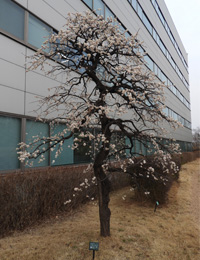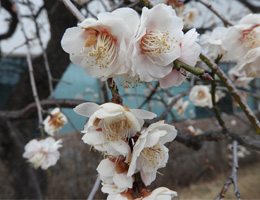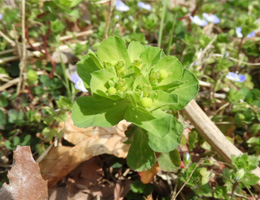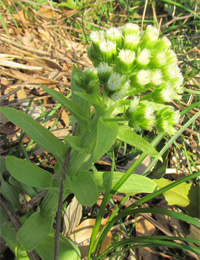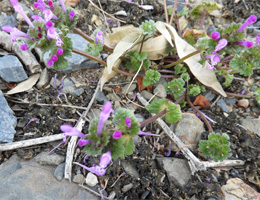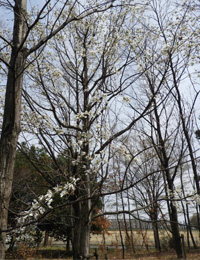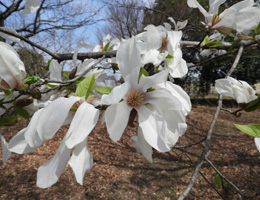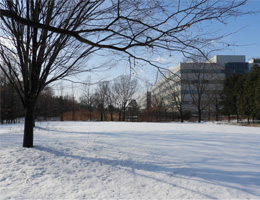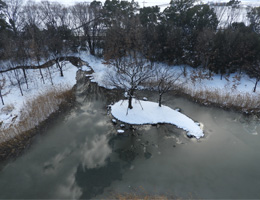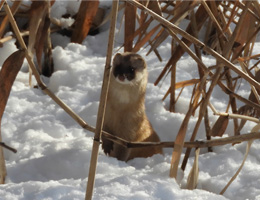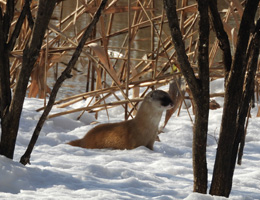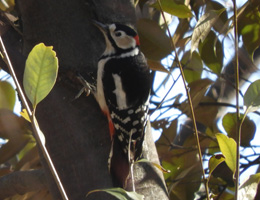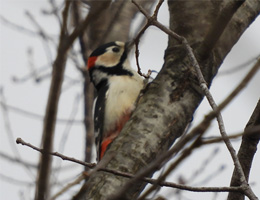Biotope Quarterly No.8
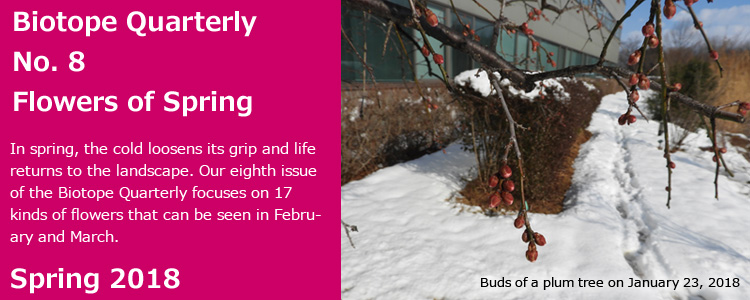
The wind and birds support the flowers of the early spring
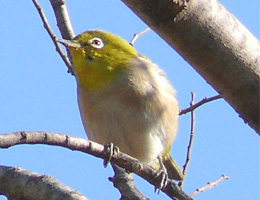
The Japanese white-eye is typical of
birds that pollinate flowers.
Many plants make their seeds by pollination of their flowers. Since plants cannot move themselves, they allow their pollen to be carried by environmental agents such as animals and wind.
Flowers borrowing the power of animals in this way tend to have eye-catching colors and shapes, a strong scent and lots of nectar. This attracts insects and birds. In particular, flowers that need birds for their pollination tend to be large and well-made so that birds can land on or near them.
Flowers borrowing the power of the wind do not need to attract insects and birds, so their petals are small and humble. The success of their pollination depends on the wind, so they have more pollen, making pollination easier. Plants that cause pollen showers—a common cause of hay-fever—such as cedar and cypress are mostly wind-pollinated.
From the end of winter to the beginning of spring, insect activity is sparse. Bird-pollinated flowers and wind-pollinated flowers are easy to see, and colorful insect-pollinated flowers are increasing. The scenery is notably different from that of warmer seasons.
Spring Flowers of the Biotope
Ume, Bird-Pollinated Japanese apricot
Most years, the Ume blooms earlier than any other flower in the biotope, but this year it was a little late and entered full bloom at the end of February.
Tsubaki, Bird-Pollinated Camellia japonicae
There are types of camellia that bloom from autumn to the beginning of winter, but the type of camellia in the biotope flowers from February to April. It is very similar to Camellia sasanqua and it is difficult to distinguish them, but whereas Camellia japonicae drops its flowers one by one, sasanqua lets its petals fall little by little.
-
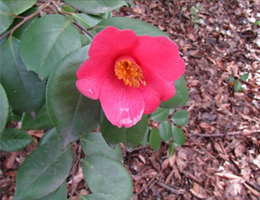
Japonicae -
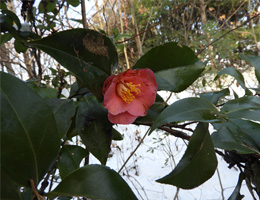
Sasanqua
Sun spurge, Wind-Pollinated Euphorbia helioscopia
Several yellow flowers are clustered in the bud. Although it is not flashy, sun spurge is easy to find because of its unique shape. The euphorbia which is popular with gardeners is a kind of sun spurge.
Butterbur, Wind-Pollinated Petasites japonicus
It is a perennial, and there are years when the plants in the biotope do not flower. The male and female flowers are separate, and the female flower turns white with fluff after pollination. The buds are called "Fuki no to," and you can eat them as tempura or in other preparations, but you have to get the bitterness out thoroughly.
Henbit dead-nettle, Wind-Pollinated Lamium amplexicaule
Flies and some butterflies are active even in this season when the cold lingers. The henbit dead-nettle is a small pink flower that can be found on the ground amidst the dry grass. It is different from "Buddha's seat," one of the seven herbs of spring, and cannot be eaten.
Some of its flowers do not open their petals and pollinate in the bud. This is called "cleistogamous" or "self pollination." While it assures pollination in one flower, the disadvantage is that the gene is weaker and the viability is also weakened. It is seen only in a few plants such as henbit and violet.
Japanese witch-hazel, Insect-pollinated Hamamelis japonica
It has characteristic slender yellow petals. As you can see below, it has the same vivid yellow petals as the forsythia that attract insects, but the shape of the flower is quite different. In our biotope, witch-hazel blooms mainly in March, forsythia mainly in April.
-
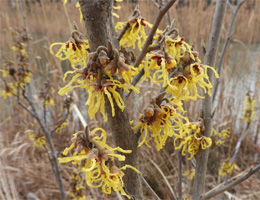
Witch-hazel -
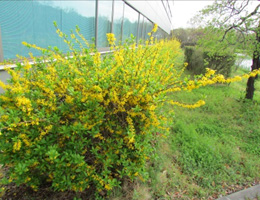
Forsythia
Kobushi magnolia, Insect-pollinated Magnolia kobus
It is a tall tree growing up to about 15 meters in height. From a distance, it looks like a sakura cherry-tree, but the size of the flower is close to 10 cm. The name Kobushi comes from the fact that the surface of the fruit is bumpy and it looks like a closed fist (fist in Japanese is kobushi).
Other spring flowers
-
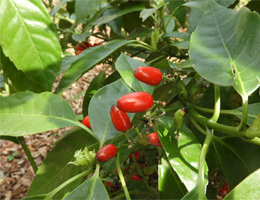
Japanese laurel, Aucuba japonica -
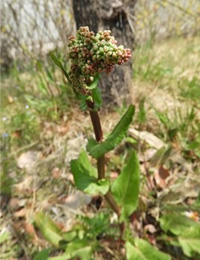
Common sorrel, Rumex acetosa
(delicious in salads) -
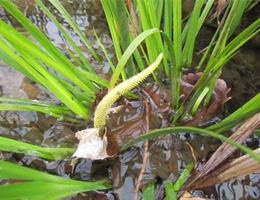
Japanese sweet flag, Acorus gramineus -
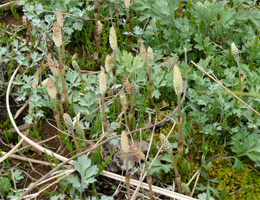
Common horsetail, Equisetum arvense -
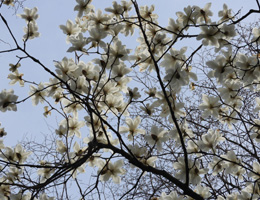
Yulan magnolia, Magnolia quinquepeta -
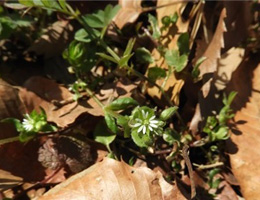
Stellaria -
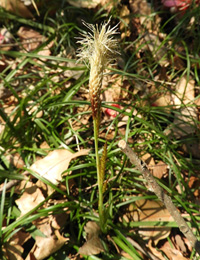
Carex conica Boott -
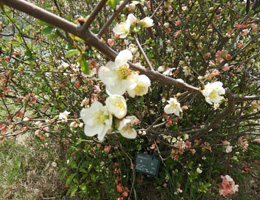
Flowering quince, Chaenomeles speciosa -
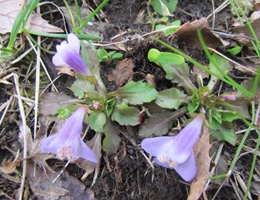
Miquel's mazus, Mazus miquelii -
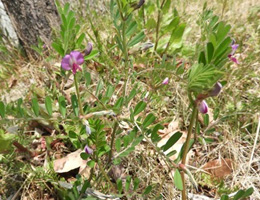
Narrow-leaved vetch, Vicia sativa subsp. nigra
Spring events in the biotope: Susuki grass cutting and reed gathering
In our biotope, March is the month for cutting back the tall Susuki grass and gathering dead reeds. As sunlight is allowed into the places where plants grew thickly, hidden flora and fauna can receive life-giving light.
In the case of the Susuki grass, we leave almost all of it and just cut down the cogon grass. The Susuki left behind provides a home for birds and insects.
Aquatic plants such as reeds help the ecosystem by sucking up dirt and cleaning the water. By gathering up the dead reeds, we prevent dirt from going back to the pond from the decaying biomass.
-
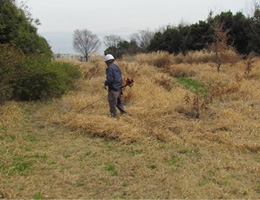
Cutting Susuki grass -
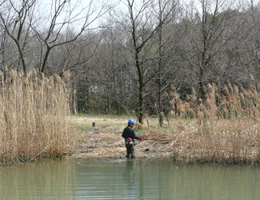
Gathering dead reeds
Encountered on a snowy day in the biotope: Weasel
From January 22 to 23, 2018, heavy snow fell on the Kanto plain, more than ten centimeters accumulated in the biotope. On the morning of the 23rd, we saw a weasel for the first time in the ten-year-plus history of the biotope.
There are several kinds of weasels in Japan, but in order to distinguish them, we look at the length of the tail. We think the weasel we saw was not a long-tailed Siberian weasel but a short-tailed Japanese weasel. In western Japan, the Siberian weasel is designated as an invasive species and it threatens the Japanese weasel.
By the way, we saw a tanuki (raccoon dog) in March 2017, and a fox on a snowy day in February 2013. It is not unusual to encounter rare animals in winter, because they are short of food then and hunt further afield and at different times from usual.
Left: snowy scener. Right: Ice on the pond. No ducks! (They all came back a few days later.)
It is probably a Japanese weasel.
Success in photographing a great spotted woodpecker
On February 14, 2018, we successfully took pictures of a great spotted woodpecker for the first time in the biotope. We sometimes see lesser woodpeckers, but almost never the great spotted variety, which usually lives in the mountains. Slightly bigger than their cousins, they also make a louder sound as they peck at trees. This behavior is called "drumming", and is a means of communication as well as a way of searching for holes that could be used as nests, and eating insects that live in the bark.
Also, the holes that woodpeckers leave are reused by various animals and insects such as squirrels and bees. Drumming rarely causes major damage to trees. In fact, it is believed to promote biodiversity.
